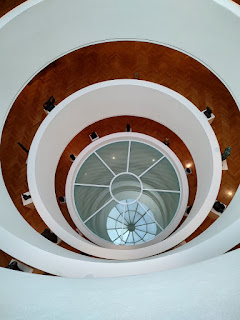Slovak National Theater
"I don't think falling in love with Slovakia is much different than falling in love with Tunbridge Wells."
---Tom Stoppard
When we started this journey, I had no idea we were even going to Slovakia. Or where Slovakia was except it was part of Czechoslovakia some time ago. So I had no expectations. Which is a good way to enter any new place.
I found out that the independent Slovak State was established in Slovakia in 1939 as an outcome of international events, however, the end of the Second World War brought about restoration of Czechoslovakia. The communist party gradually seized power in the country and the communist dictatorship was overthrown only through the Velvet Revolution in 1989. The democratic process exposed several problems, which resulted in the break-up of the common state of the Czechs and Slovaks and the establishment of the independent Slovak Republic (1 January 1993).
Slovakia is a member of the EU from May 2004. In December 2007, it became part of the Schengen Area and from 1/1/2009, upon the adoption of the single European currency Euro, Slovakia also became one of the countries of the European Monetary Union.
It seems to be a well-off nation and the streets are extremely clean. We only had an afternoon there, so we didn't learn as much as we wanted but we did find out a little history.
St Martin's Church
Interior of St Martin's Church
We took a walking tour through town with a local guide and thought we would go to the castle of Bratislava, but it was a very hot day, and I think she opted for a smaller and more level tour. We visited the site of St. Martin's church, a very nice Catholic edifice which survived WWII. The synagogue next door also survived WWII but not Communism. It was torn down to build a freeway. The guide said if they just moved the freeway about 2 meters, they could have saved the synagogue---which was right next door to the Catholic church---but there were other forces at work. In fact, we were told, Slovakians were allowed to attend church, but if they did so regularly, they were excluded from better housing, permission to leave the country and free college educations. She said many people still attended church who were from Bratislava, but they would go out to small villages where no one knew them to attend services and this kept anyone from "reporting them" to authorities.We wandered through the old town of Bratislava, a city of 500,000 people and found it to be tidy and prosperous appearing. The main street is tree-lined (very welcome on such a hot day) and also had an inordinately high number of gelato shops.
When every other shop is a gelato shop, it gets hard to resist temptation.
Old town tower
Slovakia is known for it's mechanical toys.
And several liquors. We bought some wine and it was very good. They also make a tea flavored liquor which looked interesting but varied in alcohol content from 13-78%, so we decided NOT to throw the dice on that one as we had a long walk back to the boat.
"Famous manhole cover": Cumil the Sewer Worker
This manhole cover emerges from the streets of Old Town Bratislava. Debate rages on as to what this cheeky chap is actually doing as he pokes out of a sculptural manhole in Bratislava’s old town district. The odd statue was installed in 1997 as part of an effort to spice up the look and feel of the area, which was traditionally marked with drab, Communist-era architecture and decoration. He has had his head chopped off a few times by careless motorists, apparently, and caused quite a few falls, but the Bratislavans seem to be very proud of him. To each his own?
Typical street scene of Bratislava Old Town
After visiting a manhole cover, what more is there to do in Old Town Bratislava? We were able to calm ourselves down enough to seek out the Nedbalka Gallery, a small but enjoyable art museum featuring ONLY Slovak artists. Free cup of coffee included in the museum price! We were treated to some interesting work by people you never hear about in our neck of the woods. Examples below:
Slovakian bride
Interesting piece that used the lids of canned goods
This is the inner staircase of the museum which is very similar in some ways to the Guggenheim.
Having only an afternoon in the capital of Slovakia, a trip to a local grocery and a local beer seemed in order before our trek back to the ship.
A lager and an IPA from villages less than 30 kilometers from the capital.
Paul Parris peruses produce. It looked fresh and tasty.
All in all, a good afternoon out in a place I knew pretty much nothing about and didn't even realize I was going to visit.
Paul's Ponderings: The old comment about first impressions are best impressions applies here. Things I noted about this town in no order: clean, great public transport, low key, plenty of restaurants and bars, lots of cultural activities, and more. I'd come back here and I felt like we did NOT do it full justice. It seems very affordable and a great place to stay. Hope to return some day. And as a last comment, I've checked Slovakia off my country list!


















No comments:
Post a Comment